airbag off MITSUBISHI OUTLANDER 2019 Owner's Manual (in English)
[x] Cancel search | Manufacturer: MITSUBISHI, Model Year: 2019, Model line: OUTLANDER, Model: MITSUBISHI OUTLANDER 2019Pages: 451, PDF Size: 58.02 MB
Page 4 of 451
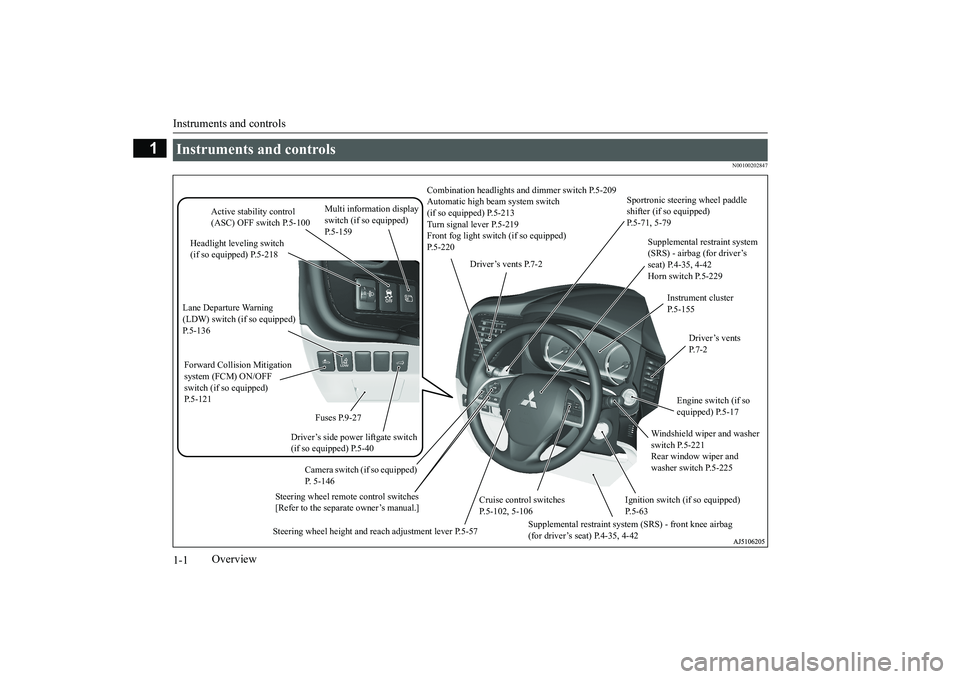
Instruments and controls 1-1
1
Overview
N00100202847
Instruments and controls
Combination headlights an
d dimmer switch P.5-209
Automatic high beam system switch (if so equipped) P.5-213 Turn signal lever P.5-219 Front fog light switc
h (if so equipped)
P.5-220
Steering wheel remote control switches [Refer to the separate owner’s manual.]
Active stability control (ASC) OFF switch P.5-100
Supplemental restraint system (SRS) - airbag (for driver’s seat) P.4-35, 4-42 Horn switch P.5-229
Instrument cluster P.5-155
Windshield wiper and washer switch P.5-221 Rear window wiper and washer switch P.5-225
Cruise control switches P.5-102, 5-106
Steering wheel height and reach adjustment lever P.5-57
Engine switch (if so equipped) P.5-17
Driver’s vents P. 7 - 2
Sportronic steering wheel paddle shifter (if so equipped) P.5-71, 5-79
Driver’s vents P.7-2
Multi information display switch (if so equipped) P.5-159
Headlight leveling switch (if so equipped) P.5-218
Driver’s side power liftgate switch (if so equipped) P.5-40
Fuses P.9-27
Lane Departure Warning (LDW) switch (if so equipped)P.5-136 Forward Collision Mitigation system (FCM) ON/OFF switch (if so equipped)P.5-121
Supplemental restraint system (SRS) - front knee airbag (for driver’s seat) P.4-35, 4-42
Ignition switch (if so equipped) P.5-63
Camera switch (if so equipped) P. 5-146
BK0264300US.book 1 ページ 2018年2月28日 水曜日 午後5時16分
Page 5 of 451
![MITSUBISHI OUTLANDER 2019 Owners Manual (in English) Instruments and controls
Overview 1-2
1
Audio (if so equipped) [Refer to the separate owner’s manual.] Multi Around Monitor (if
so equipped) P.5-146
Hazard warning flasher switch P.5-220
Electr MITSUBISHI OUTLANDER 2019 Owners Manual (in English) Instruments and controls
Overview 1-2
1
Audio (if so equipped) [Refer to the separate owner’s manual.] Multi Around Monitor (if
so equipped) P.5-146
Hazard warning flasher switch P.5-220
Electr](/img/19/34859/w960_34859-4.png)
Instruments and controls
Overview 1-2
1
Audio (if so equipped) [Refer to the separate owner’s manual.] Multi Around Monitor (if
so equipped) P.5-146
Hazard warning flasher switch P.5-220
Electric rear window defogger switch P.5-227 Wiper deicer switch (if so equipped) P.5-226 Fuel tank filler door release lever P. 3 - 3
Air conditioner P.7-5 Hood release lever P. 9 - 3
Floor console box P.5-242 Arm rest 12 V power outlet (if so equipped) P.5-232 USB input terminal (if so equipped) P.5-229
Cup holder P.5-245
12 V power outlet P.5-232
Power liftgate main switch (if so equipped) P.5-39
Key slot (if so equipped) P.5-26
Passenger’s vents P. 7 - 2
Passenger’s airbag off indicator P.4-40
Front passenger seat belt warning light P.4-23
Heated steering wheel switch (if so equipped) P.5-228
Blind Spot Warning (BSW) switch (if so equipped) P.5-126
USB input terminal (if so equipped) P.5-229
USB input terminal P.5-229
2nd seat vents (if so equipped) P. 7 - 2
BK0264300US.book 2 ページ 2018年2月28日 水曜日 午後5時16分
Page 57 of 451
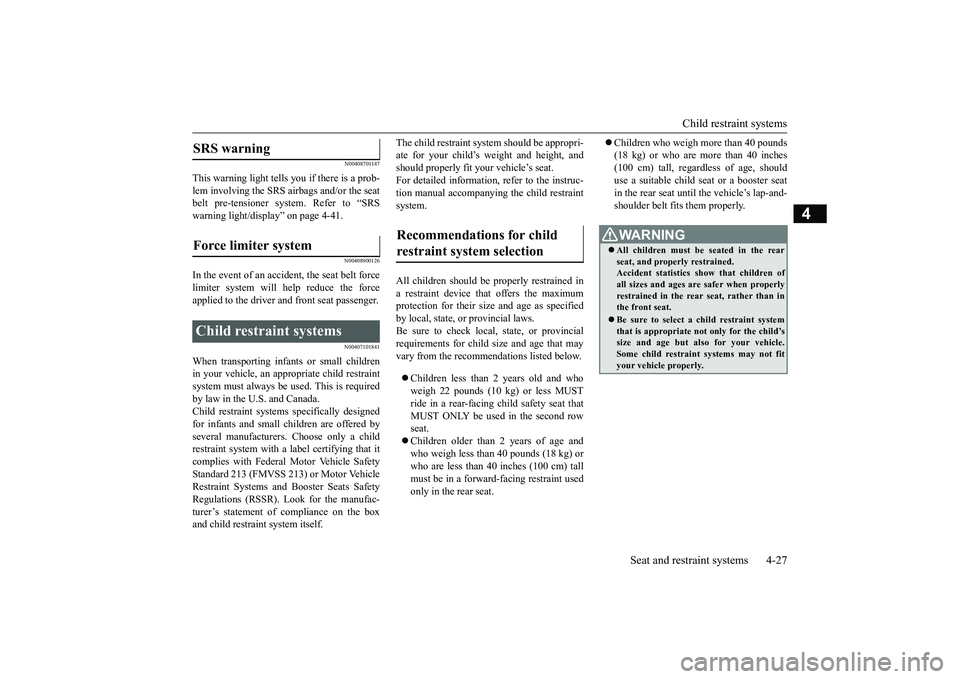
Child restraint systems
Seat and restraint systems 4-27
4
N00408701147
This warning light tells you if there is a prob- lem involving the SRS airbags and/or the seat belt pre-tensioner system. Refer to “SRSwarning light/display” on page 4-41.
N00408900126
In the event of an accident, the seat belt force limiter system will help reduce the force applied to the driver a
nd front seat passenger.
N00407101841
When transporting infants or small children in your vehicle, an appr
opriate child restraint
system must always be
used. This is required
by law in the U.S. and Canada. Child restraint systems specifically designedfor infants and small children are offered by several manufacturers. Choose only a child restraint system with a label certifying that itcomplies with Federal Motor Vehicle Safety Standard 213 (FMVSS 213) or Motor Vehicle Restraint Systems and
Booster Seats Safety
Regulations (RSSR).
Look for the manufac-
turer’s statement of compliance on the box and child restraint system itself.
The child restraint system should be appropri- ate for your child’s we
ight and height, and
should properly fit your vehicle’s seat. For detailed information,
refer to the instruc-
tion manual accompanying the child restraintsystem. All children should be properly restrained in a restraint device that offers the maximumprotection for their size and age as specified by local, state, or provincial laws. Be sure to check local,
state, or provincial
requirements for child size and age that may vary from the recommendations listed below. Children less than 2 years old and who weigh 22 pounds (10 kg) or less MUSTride in a rear-facing child safety seat that MUST ONLY be used in the second row seat. Children older than 2 years of age and who weigh less than 40 pounds (18 kg) or who are less than 40 inches (100 cm) tallmust be in a forwar
d-facing restraint used
only in the rear seat.
Children who weigh more than 40 pounds (18 kg) or who are more than 40 inches(100 cm) tall, regardless of age, should use a suitable child seat or a booster seat in the rear seat until the vehicle’s lap-and-shoulder belt fits
them properly.
SRS warning Force limiter system Child restraint systems
Recommendations for child restraint system selection
WA R N I N G All children must be seated in the rear seat, and properly restrained.Accident statistics
show that children of
all sizes and ages are safer when properly restrained in the rear seat, rather than inthe front seat. Be sure to select a child restraint system that is appropriate not only for the child’s size and age but also for your vehicle. Some child restraint systems may not fityour vehicle properly.
BK0264300US.book 27 ページ 2018年2月28日 水曜日 午後5時16分
Page 68 of 451

Supplemental Restraint System (SRS) - airbag 4-38 Seat and restraint systems
4
N00407801532
The SRS includes the following components:
The airbag control unit monitors the readiness of the electronic parts of the system whenever the ignition switch or the operation mode is under the following conditions. These include all of the items listed
above and all related
wiring.[Except for vehicles
equipped with the
F. A . S . T. - k e y ] The ignition switch is in the “ON” or“START” position. [Vehicles equipped with the F.A.S.T.-key] The operation mode is in ON. The airbags will opera
te under the same con-
ditions as the airbag control unit.
When the impact sensors detect a sufficient front or side impact to deploy the airbag(s),the appropriate airbag
(s) will be deployed.
When the airbag control unit detects rollover of the vehicle, curtain airbags will be deployed. When airbags deploy, so
me smoke is released
accompanied by a loud noise. The smoke is not harmful, but do not intentionally inhale the smoke as it may ca
use temporary irrita-
tion to people with respiratory problems. An inflated airbag will deflate quickly, so you may not even notice that the airbag wasinflated. Airbag inflation does not prevent the driver from seeing or being able to steer the vehicle,and does not prevent people from leaving the vehicle.
N00418601266
This vehicle is equipped with an event data recorder (EDR).
How the Supplemental Restraint System works 1- Airbag module (Driver) 2- SRS warning light 3- Passenger’s airbag off indicator 4- Front impact sensors5- Airbag module (Passenger) 6- Airbag module (Driver’s knee) 7- Driver’s seat position sensor8- Passenger’s seat oc
cupant classifica-
tion sensor system
9- Airbag control unit
10- Side airbag modules11- Curtain airbag modules12- Side impact sensors
CAUTION Airbags inflate very quickly and with great force. In certain situ
ations, contact with an
inflating airbag may cause small cuts, abra- sions, and bruises.
Event Data Recording
BK0264300US.book 38 ページ 2018年2月28日 水曜日 午後5時16分
Page 70 of 451
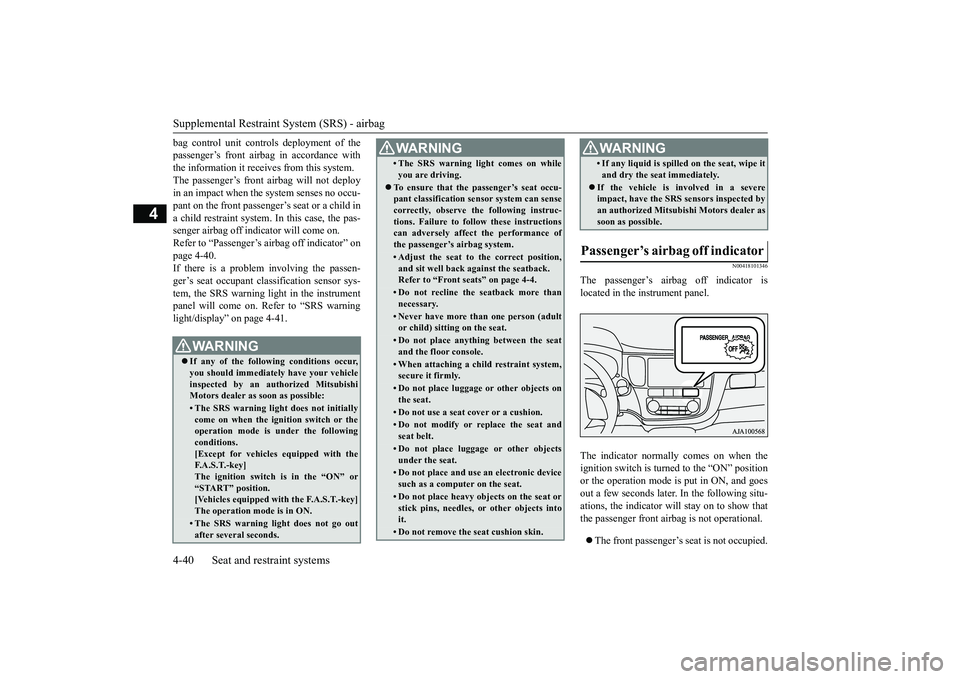
Supplemental Restraint System (SRS) - airbag 4-40 Seat and restraint systems
4
bag control unit controls deployment of the passenger’s front airbag in accordance withthe information it receives from this system. The passenger’s front airbag will not deploy in an impact when the system senses no occu-pant on the front passenger’s seat or a child in a child restraint system. In this case, the pas- senger airbag off indi
cator will come on.
Refer to “Passenger’s ai
rbag off indicator” on
page 4-40. If there is a problem involving the passen- ger’s seat occupant cl
assification sensor sys-
tem, the SRS warning light in the instrumentpanel will come on. Refer to “SRS warning light/display” on page 4-41.
N00418101346
The passenger’s airbag off indicator is located in the instrument panel. The indicator normally comes on when the ignition switch is turned to the “ON” position or the operation mode is put in ON, and goes out a few seconds later.
In the following situ-
ations, the indicator will stay on to show that the passenger front airb
ag is not operational.
The front passenger’s seat is not occupied.
WA R N I N GIf any of the follow
ing conditions occur,
you should immediatel
y have your vehicle
inspected by an au
thorized Mitsubishi
Motors dealer as soon as possible:• The SRS warning light does not initiallycome on when the ignition switch or the operation mode is under the followingconditions. [Except for vehicles equipped with the F. A . S . T. - k e y ]The ignition switch is in the “ON” or “START” position. [Vehicles equipped with the F.A.S.T.-key]The operation mode is in ON.• The SRS warning light does not go outafter several seconds.
• The SRS warning li
ght comes on while
you are driving.
To ensure that the passenger’s seat occu- pant classification sensor system can sense correctly, observe the following instruc-tions. Failure to follow these instructions can adversely affect
the performance of
the passenger’s airbag system.• Adjust the seat to the correct position,and sit well back
against the seatback.
Refer to “Front seats” on page 4-4.• Do not recline the seatback more thannecessary.• Never have more th
an one person (adult
or child) sitting on the seat.• Do not place anything between the seatand the floor console.• When attaching a child restraint system,secure it firmly.• Do not place luggage or other objects onthe seat.• Do not use a seat cover or a cushion.• Do not modify or re
place the seat and
seat belt.• Do not place luggage or other objectsunder the seat.• Do not place and use
an electronic device
such as a computer on the seat.• Do not place heavy obje
cts on the seat or
stick pins, needles, or other objects intoit.• Do not remove the seat cushion skin.WA R N I N G
• If any liquid is spilled on the seat, wipe itand dry the seat immediately.
If the vehicle is involved in a severe impact, have the SRS sensors inspected by an authorized
Mitsubishi Motors dealer as
soon as possible.
Passenger’s airbag off indicator
WA R N I N G
BK0264300US.book 40 ページ 2018年2月28日 水曜日 午後5時16分
Page 71 of 451
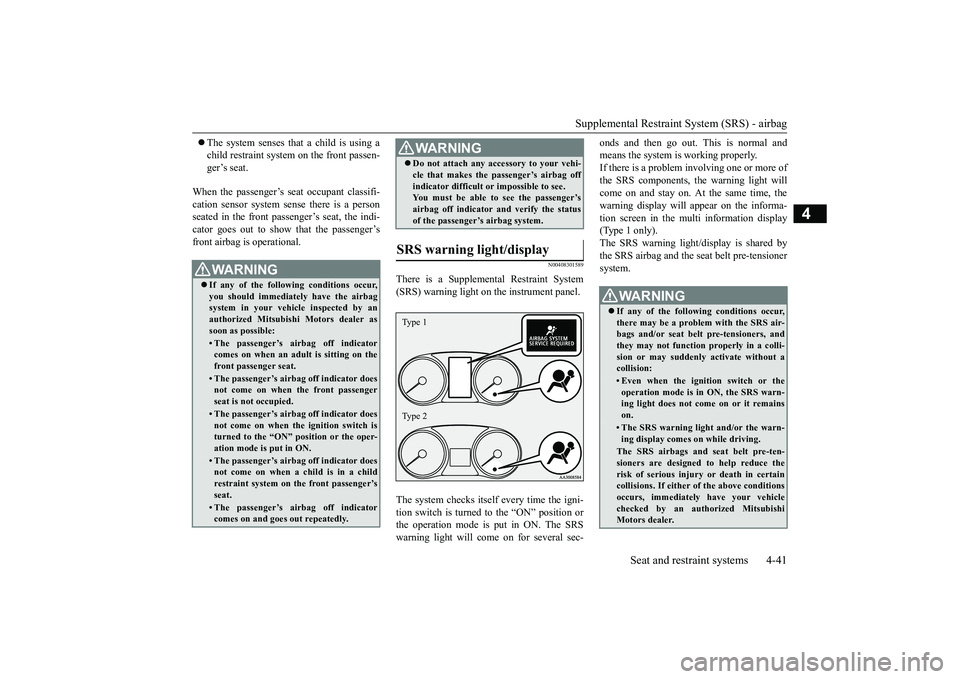
Supplemental Restraint System (SRS) - airbag
Seat and restraint systems 4-41
4
The system senses that a child is using a child restraint system
on the front passen-
ger’s seat.
When the passenger’s se
at occupant classifi-
cation sensor system sense there is a person seated in the front passenger’s seat, the indi-cator goes out to show that the passenger’s front airbag is operational.
N00408301589
There is a Supplemen
tal Restraint System
(SRS) warning light on the instrument panel. The system checks itself every time the igni- tion switch is turned to the “ON” position orthe operation mode is put in ON. The SRS warning light will come on for several sec-
onds and then go out. This is normal and means the system is working properly.If there is a problem
involving one or more of
the SRS components, the warning light will come on and stay on. At
the same time, the
warning display will appear on the informa- tion screen in the multi information display (Type 1 only).The SRS warning light/display is shared by the SRS airbag and the se
at belt pre-tensioner
system.
WA R N I N G If any of the following conditions occur, you should immediat
ely have the airbag
system in your vehicle inspected by anauthorized Mitsubishi
Motors dealer as
soon as possible:• The passenger’s airbag off indicatorcomes on when an adul
t is sitting on the
front passenger seat.• The passenger’s airbag off indicator doesnot come on when the front passengerseat is not occupied.• The passenger’s airbag off indicator doesnot come on when the ignition switch is turned to the “ON” position or the oper- ation mode is put in ON.• The passenger’s airbag off indicator doesnot come on when a
child is in a child
restraint system on the front passenger’s seat.• The passenger’s airbag off indicatorcomes on and goes out repeatedly.
Do not attach any accessory to your vehi- cle that makes the passenger’s airbag offindicator difficult or
impossible to see.
You must be able to see the passenger’s airbag off indicator an
d verify the status
of the passenger’s airbag system.
SRS warning light/display
WA R N I N G
Type 1 Type 2
WA R N I N G If any of the following conditions occur, there may be a problem with the SRS air- bags and/or seat belt
pre-tensioners, and
they may not function
properly in a colli-
sion or may suddenly
activate without a
collision:•Even when the igniti
on switch or the
operation mode is in ON, the SRS warn- ing light does not come on or it remainson.• The SRS warning light and/or the warn-ing display comes
on while driving.
The SRS airbags and
seat belt pre-ten-
sioners are designed to help reduce the risk of serious injury
or death in certain
collisions. If either of the above conditionsoccurs, immediately
have your vehicle
checked by an auth
orized Mitsubishi
Motors dealer.
BK0264300US.book 41 ページ 2018年2月28日 水曜日 午後5時16分
Page 274 of 451
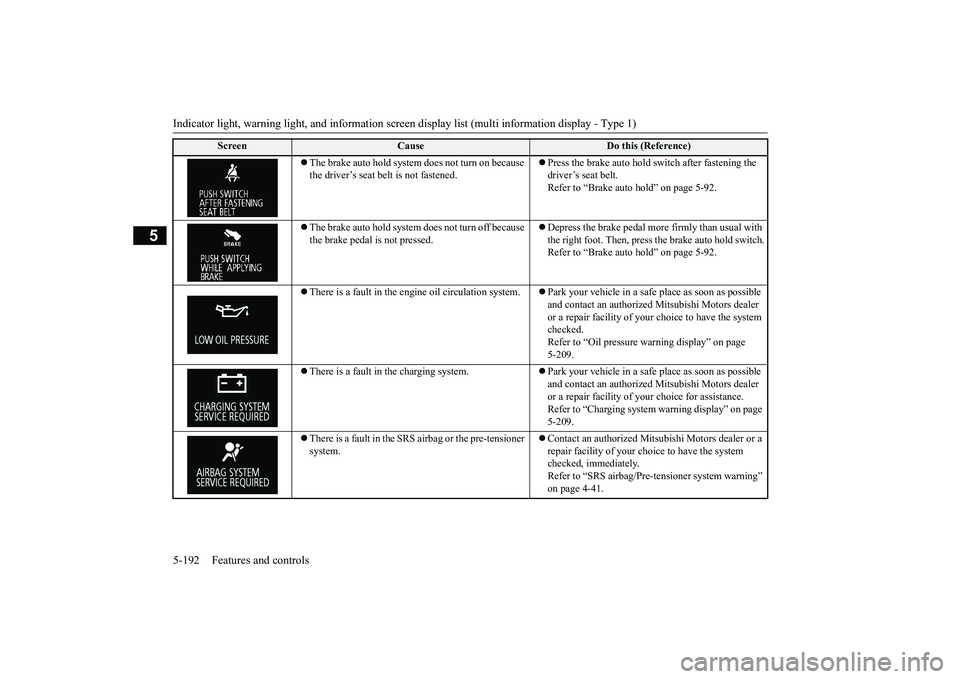
Indicator light, warning light, and information screen display list (multi information display - Type 1) 5-192 Features and controls
5
The brake auto hold system does not turn on because the driver’s seat belt is not fastened.
Press the brake auto hold switch after fastening the driver’s seat belt.Refer to “Brake auto hold” on page 5-92.
The brake auto hold system does not turn off because the brake pedal is not pressed.
Depress the brake pedal more firmly than usual with the right foot. Then, press
the brake auto hold switch.
Refer to “Brake auto hold” on page 5-92.
There is a fault in the engi
ne oil circulation system.
Park your vehicle in a safe place as soon as possible and contact an authorized
Mitsubishi Motors dealer
or a repair facility of your
choice to have the system
checked. Refer to “Oil pressure wa
rning display” on page
5-209.
There is a fault in the charging system.
Park your vehicle in a safe place as soon as possible and contact an authorized
Mitsubishi Motors dealer
or a repair facility of
your choice for assistance.
Refer to “Charging system
warning display” on page
5-209.
There is a fault in the SRS airbag or the pre-tensioner system.
Contact an authorized Mits
ubishi Motors dealer or a
repair facility of your c
hoice to have the system
checked, immediately.Refer to “SRS airbag/Pre-t
ensioner system warning”
on page 4-41.
Screen
Cause
Do this (Reference)
BK0264300US.book 192 ページ 2018年2月28日 水曜日 午後5時16分
Page 374 of 451
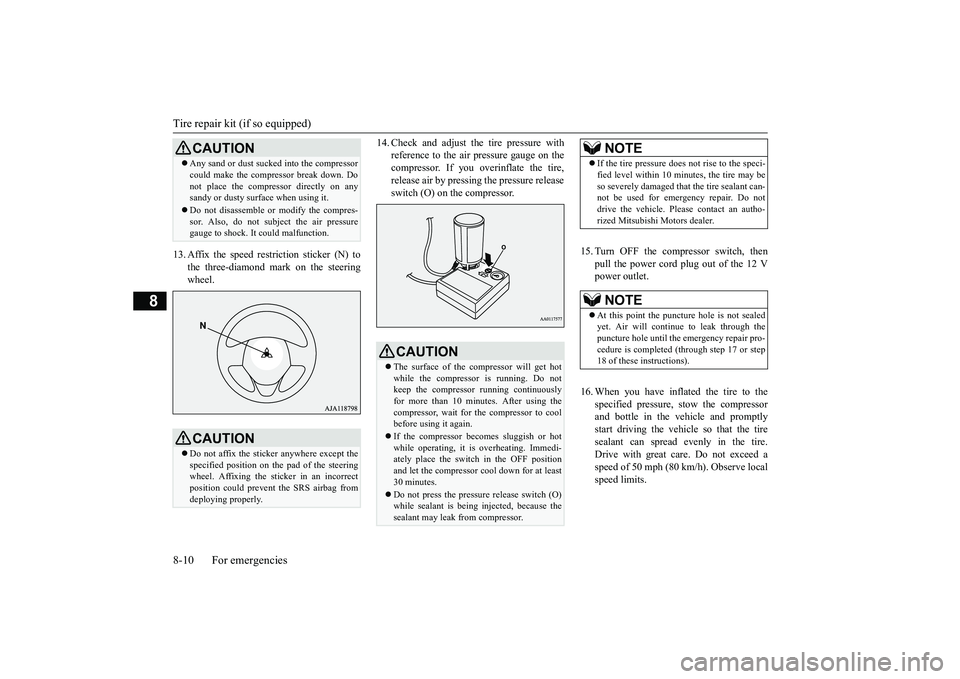
Tire repair kit (if so equipped) 8-10 For emergencies
8
13. Affix the speed restriction sticker (N) to
the three-diamond mark on the steeringwheel.
14. Check and adjust the tire pressure with
reference to the air pressure gauge on thecompressor. If you overinflate the tire, release air by pressing the pressure release switch (O) on the compressor.
15. Turn OFF the compressor switch, then
pull the power cord plug out of the 12 Vpower outlet.
16. When you have inflated the tire to the
specified pressure, stow the compressor and bottle in the vehicle and promptlystart driving the vehicle so that the tire sealant can spread evenly in the tire. Drive with great care. Do not exceed aspeed of 50 mph (80 km/h). Observe local speed limits.
Any sand or dust sucked into the compressor could make the compressor break down. Donot place the compressor directly on anysandy or dusty surface when using it. Do not disassemble or modify the compres- sor. Also, do not subject the air pressure gauge to shock. It could malfunction.CAUTION Do not affix the sticker anywhere except the specified position on th
e pad of the steering
wheel. Affixing the sticker in an incorrect position could prevent the SRS airbag from deploying properly.CAUTION
CAUTION The surface of the compressor will get hot while the compressor is running. Do not keep the compressor running continuously for more than 10 minutes. After using thecompressor, wait for the compressor to cool before using it again. If the compressor becomes sluggish or hot while operating, it is
overheating. Immedi-
ately place the switch in the OFF positionand let the compressor c
ool down for at least
30 minutes. Do not press the pressure release switch (O) while sealant is being injected, because the sealant may leak from compressor.
NOTE
If the tire pressure does not rise to the speci- fied level within 10 minutes, the tire may beso severely damaged that the tire sealant can-not be used for emergency repair. Do not drive the vehicle. Plea
se contact an autho-
rized Mitsubishi Motors dealer.NOTE
At this point the puncture hole is not sealed yet. Air will
continue to leak through the
puncture hole until the emergency repair pro-cedure is completed (through step 17 or step 18 of these instructions).
BK0264300US.book 10 ページ 2018年2月28日 水曜日 午後5時16分